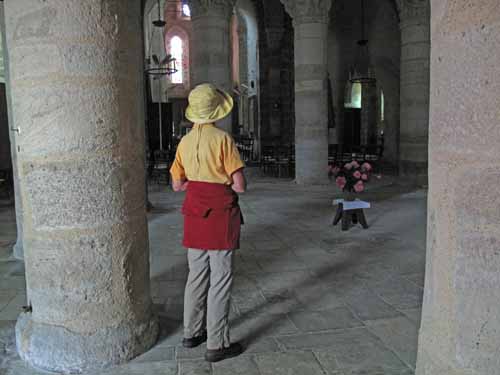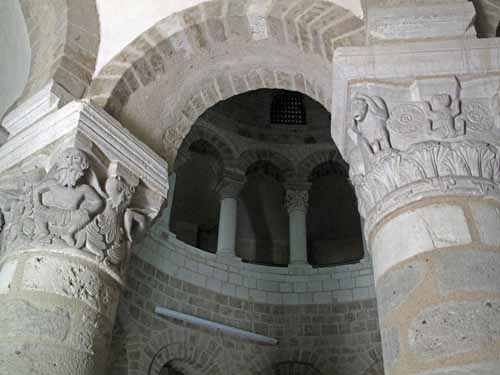
Sunday, 30 May 2010
Distance 25 km
Duration 4 hours 55 minutes
Ascent 578 m, descent 528 m
Map 35 of the TOP100 blue series (or Map 140 in the new lime-green series)
Topoguide (ref. 6542) Sentier vers Saint-Jacques-de-Compostelle via Vézelay
Towards dawn it began to drizzle and by the time we were ready to rise it was raining steadily. We bundled everything over to the laundry block, where there were draining boards to put it all on.
Breakfast was taken standing up, but our muesli was much improved by the bananas from yesterday’s market. When we left at 8 am, it had stopped raining but the sky did not inspire confidence. Our fellow pilgrim, the cyclist, put his head out to say goodbye, adding that he had not decided whether to go or stay today.

Once again we disobeyed the GR signs, as Keith had noticed on the map a little road going under the railway line in the general direction that we wanted.
Turning sharp left at the gates of the camping ground, we walked along an avenue of dripping plane trees, through the underpass and onto a bigger road, but we only stayed on it for a kilometre before turning into a lane that took us past Preugnarrault and Chavigner, where we rejoined the GR.
Part of the way was bitumen and part a gravel wheel track through meadows dense with recent rain.

Soon our shoes were saturated and I was dismayed to find that my newly repaired soles were coming apart again, having lasted only two days.
The mist that cloaked the far hills thickened and congealed into light rain.
Ahead of us appeared a tall edifice that would have been a collection of wheat silos in our native land, but here revealed itself as a fortified château of considerable antiquity.
It was built in the fourteenth century, during the Hundred Years War, when Sarzay was on the very edge of the kingdom of France, hard up against the English possessions of Limousin and Poitou.

It survived, not only the Hundred Years War, but the Wars of Religion and the Revolution, so its builders would have been proud, had they known.
Needless to say, the château of Sarzay was used by George Sand as the setting of one of her novels – she was a prolific writer.
The last kilometre into the village was on the road and we were reminded several times on hand written signs that the marriage of Damien and Sandra would take place today.

The rain had eased when we got to the top of the rise and came to the vine-covered inn. It looked deserted and there was furniture stacked against the door on the inside when we peered in, but just then a man bustled out from somewhere and removed the barricade, welcoming us in to his tiny bar.
On either side there were dining rooms elaborately set and decorated for the wedding. We were grateful to be in this cosy place and asked for coffee and perhaps some croissants. Our host said he had no croissants but would we like fresh bread with butter and jam?

Soon we were happily devouring a basketful of bread with great slabs of butter and home-made jam. Seeing our appetites, the man offered us another basketful but we declined with an effort. The whole thing cost us €6.

Meanwhile some of the bridesmaids and relatives arrived for drinks to steady their nerves for the great event. As we left we passed on our best wishes to the absent Damien and Sandra.
Out in the drizzle again, we decided to take the short route to Neuvy-Saint-Sépulchre, along a small descending road, instead of the complicated GR.
We spread our plastic capes across our fronts, which was enough protection until five minutes before we got to the town, when it started to rain in earnest.
We scuttled down the main street, snatched a baguette from a market truck and dived into the first bar we came to. Whilst drinking our coffee we had a bit of bread and cheese and the last of the magnificent tomato from la Châtre.

We asked the barman whether there was anywhere to eat in Cluis, our destination, on a Sunday evening. He threw the question to the assembled drinkers and it was agreed that there would be no trouble – there were three restaurants there, as well as a camping ground.
Before leaving we paid a visit to the church of the Holy Sepulchre across the street from the bar. The history of this ungainly mass goes back to the mid-eleventh century.

A standard-issue Romanesque basilica was jammed awkwardly against a rotunda, a replica of the one on Christ’s tomb in Jerusalem, not in alignment with the basilica and initially not even accessible from it.
The construction was undertaken by a local lord who had gone on a pilgrimage to the Holy Land in 1040, before the first crusade. It is the only church of its type in France.
Two hundred years later, one of his descendants, a cardinal who had been on the seventh crusade with Louis IX, brought back two drops of Christ’s blood in the shape of tears, and a fragment of the holy tomb.

These relics he deposited in the church of Neuvy, his birthplace, making it an instant magnet for pilgrims and ensuring the prosperity of the town for generations.
In the shadowed depths of the rotunda we noticed that there were other pilgrims – the man with the one-wheeled cart and another dark-bearded fellow of ruffianly appearance that we had never seen before. When we stepped out into the street we met the Dutch cyclist who had camped with us at Montgivray, who had decided to move on after all.
With the weather being so dubious and all the countryside drenched, we decided to keep on the D38 for the last part of the day’s walk. There was something comforting about bitumen in these circumstances, especially as the road was practically devoid of cars.

When we got to the substantial village of Mouhers, preparations for a bike race were under way. Roads were barricaded and yellow-vested officials barked into their mobile phones. They told us that the riders would come past in ten minutes so we waited on a park bench near the war memorial.
In all our years of walking in France we had never managed to see the Tour de France, so this was our little consolation. As we sat there attending to our blisters, the two pilgrims whom we had seen at Neuvy plodded past with a wave.
We and a handful of householders were the whole of the spectators as the peleton (rather an elderly lot) swept towards us and around the corner.

Then it was only half an hour’s easy walking before we saw, on a rise above the river, the remains of the fortress of Cluis-Dessous with its great squat towers and ragged stumps of wall. It was no older than the church at Neuvy but had been allowed to decay.
Passing a small chapel, we continued to the highway and entered Cluis itself. The first thing we saw was a bare expanse the size of a football field, with a halle at the far side, handsome in a darkly brooding way.
Further away behind some houses rose the massive clock-tower of the church, clad in a helmet of black iron. Both of them had an air of Darth Vader about them. There was no sign of a shop or a bar.
Following our rule of thumb – when in doubt, head for the church – we soon found a bar and whilst drinking our coffee, received the bad news that all the restaurants were closed (the familiar curse of Sunday) and so was the camping ground.

However, our hostess said there was a gîte for pilgrims just across the street, close beside the church. She made a phone call and soon a woman appeared and escorted us over to a low door opening into a room with a table and a small kitchen.
Another couple were already installed in two of the four beds upstairs, so our arrival filled the gîte to capacity.
We wondered what had become of the two pilgrims who had passed us at Mouhers (later we learned that they had dossed down miserably in the wet, empty camping ground).
Our companions for the night, Joël and Agnès, were from the Ardennes in the very north of France and were seven weeks into what they hoped would be a five-month pilgrimage to Compostela. They had left their three grown sons to fend for themselves.

Joël had recently left his job as an architectural draughtsman and had no intention of returning. This trip, apart from its religious significance (they were very devout), was a declaration of independence from the long hours and stress of his former life, and everything about it was a delight to him, even the rain and the poor gîte food.
Their only worry was that Agnès had developed ankle problems and could walk only 15 km a day, often less. At that rate they would take months to get to Compostela.
Late in the afternoon the supermarket next door to the bar opened and we hurried across to buy the wherewithal for dinner – a tin of cassoulet, some salad vegetables and a bottle of wine. The shop was run by a jovial Moroccan, so once again we had cause to thank the infidel for saving us on a Christian holiday.
Back at the gîte, the woman who had taken us there came back and collected €7 each from us, then stamped our créanciales – or would have if we had had such a thing. As it was, we explained airily that in Australia créanciales did not exist, so we got a stamp in our Topoguide instead. Strictly speaking, gîtes are only open to pilgrims carrying créanciales.

The evening meal was a jolly affair. Joël and Agnès, who were on a tight budget of €15 each per day, had a tin of tuna, a capsicum and some bread. We heated up our cassoulet, made a salad, and opened the wine. Our new friends took little persuading to join us in draining the bottle.
Joël apologised for not speaking English at all, even though he had learned it at school. His excuse was that the English teacher was young and pretty, and when she sat down beside him in her low-cut dress he was robbed of the power of thought.
In any case, English was impossible to pronounce – the saying in France is that you need to have a hot potato in your mouth to do it. I would have replied that to speak French you need to have a peg on your nose, but I could not think of the word for “peg” (it is “pince”, I later found out).

The other interesting topic over dinner was the pilgrim guide that they were carrying, quite a different thing from our Topoguide, which was put out by the French Walking Federation.
Theirs was produced by the Friends of Saint Jacques, a religious organisation. It consisted of a stack of laminated maps the size and weight of a brick, and a small guidebook. The pilgrim track was marked with blue and yellow signs and was usually more direct than the GR, not hesitating to take minor roads when the alternative was too circuitous.
At last we understood why the blue and yellow signs were often at odds with the red and white ones.
Previous day: Châteaumeillant to Montgivray